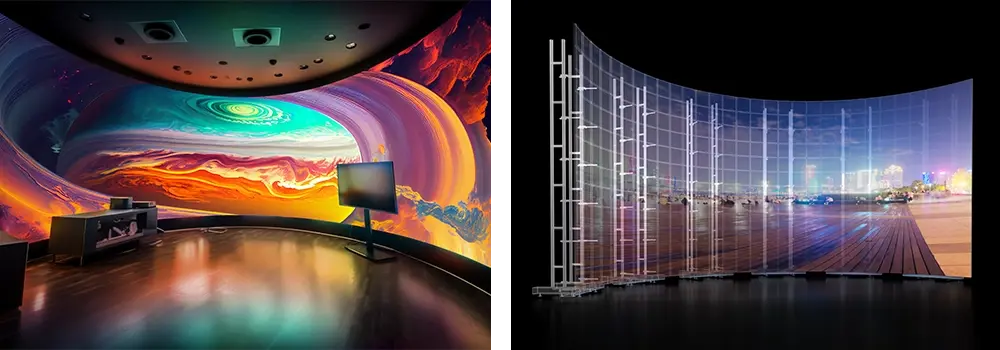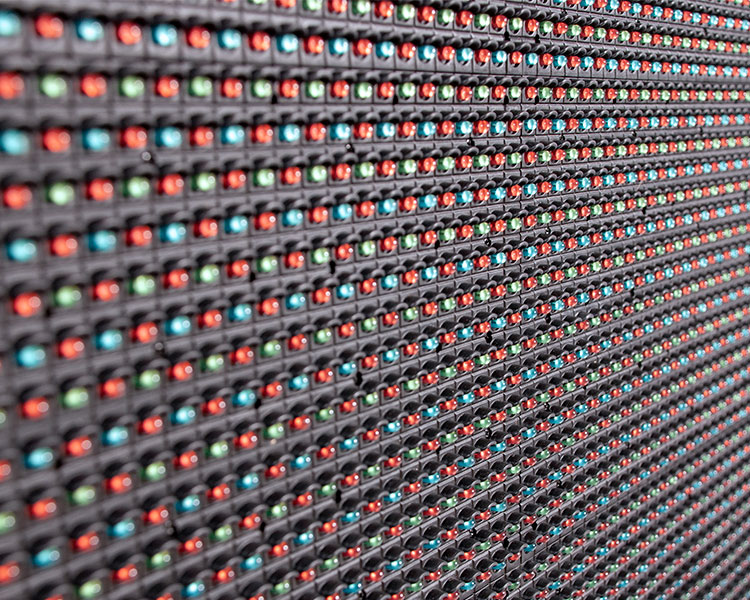Top Info For Choosing Quality Rental Led Display
Wiki Article
What Are The Top Aspects To Take Into Consideration When Selecting An Led Display?
In the research of LED displays resolution and pixel size are very important. These two factors directly affect the quality of detail as well as the overall visual impression provided by the LED display. The reason they matter so much:
1. Image Quality
Pixel Pitch The distance between the centers of each LED pixel and the centers of the subsequent pixels is known as the pixels pitch. A lower pixel pitch means that the LEDs will be more in proximity. This means greater pixel density and better resolution. This leads to sharper images that have more clarity, which is especially essential for images or texts that has finer specifics.
Resolution: This is the total number of pixels displayed, usually determined in the form of width x height (e.g. 1080 x 1920). A higher resolution permits greater detail to be shown and creates an immersive experience. This is crucial for large-screens, as the viewer is situated close to the screen.
2. Distance to view
Pixel pitch plays a major impact on the viewing distance. To avoid pixelation, displays that are viewed closely, like those in exhibitions and retail stores, or in indoor displays, require a smaller pixel-pitch (and higher resolution). A larger pixel size could suffice for large outdoor displays or billboards which will be seen from a distance.
3. Content Versatility
Displays that have a smaller pixel pitch and higher resolution are able to handle a greater range of content types, from high-definition videos to intricate graphics as well as small text. This versatility is crucial for applications that need high-quality content, like digital signage, broadcast studios or control rooms.
4. Costs
While a smaller size offers higher image quality, it can also increase the cost of the display. A screen with higher resolution is more costly due to the increased amount of LEDs required. Therefore, it's important to think about the screen's application, distance to view and budget when balancing the requirement for screens with high resolution.
5. Application Specificity
The application will determine the importance of pixel pitches and resolution.
Indoor Displays: Smaller pixels (e.g. 1.2mm to 2.4mm) is often required to attain high resolution when viewing at close distances.
Outdoor Displays: May be larger in pixel pitch (e.g. 4mm to 10mm) because they are viewed from a greater distance, and the resolution is less important.
6. The durability and upgradability
Pixel pitch is shrinking as display technology advances. This permits higher resolutions and smaller spaces. Displays with high pixel density will stay in use for a long time and reduce the need for updates.
Conclusion:
Pixel pitch, resolution and experience when viewing are crucial to the efficiency of LED displays, especially with regard to the quality of images and the variety of content. To select the ideal LED display that fits your application budget, size, and viewers, it is important to consider all of these factors. Take a look at the top smd screens for more tips including led the wall, led screen for outdoor, transparent led screen, rental led display screen, transparent display monitor, led wall tv, led transparent display, monitor transparent, led panels, wall tv led and more.

When Selecting An Led Display How Important Is It To Take Into Account The Refresh Rate?
When researching LED display, how crucial is the rate of refresh Particularly when it is used to display live content such as videos live broadcasts, interactive applications. Here are a few of the reasons the refresh is important:
1. Image Smoothness and Clarity
Definition: The term "refresh rate" is the frequency per second (measured in Hertz or Hz) that the display updates its image. A higher refresh rate will result in a smoother motion and less flickering.
Important: For displays that display video content such as animated images, or fast-moving graphics, a higher speed of refresh (such as 3,840Hz or higher) will ensure that the motion is fluid and without stuttering. This is of particular importance for applications such sports arenas, concert halls and digital signage that enhance the viewing experience.
2. Flickerless Performance
Flicker: Displays with low refresh rates can produce noticeable flickering, particularly when seen through a camera, or slow-motion videos. Flickering images can cause eye strain or fatigue, making it uncomfortable to look at the screen for long periods of time.
Application: A high-refresh rate is ideal for areas which will be filmed or photographed, such as broadcasting studios and events. It minimizes flickering, which ensures a clean capture of the content without any visual artifacts.
3. Visual Quality of different lighting conditions
High refresh rates also affect the brightness of the display under different lighting conditions. In bright environments, for example an increased refresh rate can help maintain image quality, stability and minimize any flickering that could detract the display's efficacy.
Use: This can be helpful in outdoor displays or stage events where the lighting can change frequently.
4. Content Compatibility
Synchronization. The refresh rate must be compatible with content sources like video replay cameras, systems or live broadcast feeds. The display refresh rate must match the frame rate of content to prevent judder and unmatched frames. This can adversely affect the experience of watching.
Application: To ensure seamless playback in professional environments such as large-scale events and TV studios, it's important to ensure that the rate of refresh is in line with frame rates of the content.
5. Improve Your Viewing Experience
Motion Handling: High-refresh rates are more adept at handling high-speed content, reducing blurring and delivering better clarity and a more precise image. This is especially beneficial for broadcasting sports, games or other situations in which rapid-paced action is shown.
Application: In venues with high-quality gaming, sports, or other content A fast refresh rate will ensure that viewers can see every detail clearly.
6. Reduced Eye Strain
Comfort: Low-refresh rates could result in eye strain, particularly in environments that are near the screen and also when content is displayed for long periods.
Application: In retail, office, or public environments where people will be viewing the display for an extended duration and a faster refresh rate can contribute to an enjoyable and relaxing atmosphere.
7. Performance in Rental and Staging Applications
Flexibility: For rental and staging LED displays that are utilized in a variety of settings and for different types of content, having a fast refresh rate means that the display is able to meet the demands of any occasion, whether it's live performances corporate presentations, live performances, or multimedia displays.
Application: In the context of an array of kinds of content and audience high-speed refresh is crucial for ensuring flexibility and dependability.
Conclusion:
The refresh rate directly affects the quality of images, comfort and versatility of LED displays. It is vital for applications that need live or dynamic content. When looking into LED display options, make sure you choose high refresh rates for a smooth and slick performance. This can enhance the viewer experience, as well as meet the demands of your specific application. Follow the best led rental screen for website advice including display device, flexible led screen, flexible led display, led display device, outdoor screen led, led screen panels, transparent display monitor, led board rental, flexible led display, translucent led screen and more.

What Is The Significance Of Calibration And Color Accuracy In Research On Led Display?
Particularly, the accuracy of color and calibration is crucial for LED displays that have to be utilized in applications which require superior visual quality. Here are a few reasons why these factors matter.
1. Realism, Quality of Vision and Authenticity
Color Accuracy: This refers to how faithfully an LED display reproduces the colors intended by the creators of the content. High-quality color accuracy guarantees that images and videos look real and vivid and colors appear exactly just as they should, without distortion or unnatural shifts.
Important: In cases such as broadcasting and advertising retail, professional and professional presentations, a precise colour reproduction is crucial to maintaining visual appeal and effectively delivering the message.
2. Brand Integrity
Consistency is essential in branding. Companies that employ specific color schemes rely on accuracy in color. Any deviation from the right color scheme could damage the reputation of the brand.
Application: Keeping brand colors in the right way when it comes to retail displays, corporate settings and in advertising is vital to ensure consistent brand representation on all platforms and media.
3. Engagement and Impact of Audience
Improved Viewer Experience Superior color accuracy can create an immersive, stimulating and immersive experience for your viewers. Accurate color helps convey emotion and information more effectively. This increases the overall impact.
Applications: In settings such as museums, entertainment venues or any other place where the intention is to trigger emotional reactions, color accuracy can ensure that your audience receives the ideal experience.
4. Content Creators Intent
True Representation Design, artists and content creators frequently put a lot of effort into creating images using particular color palettes. An LED display that can precisely reproduce these colors can ensure that their work is presented exactly as they intend.
Application: In fields like photography, digital art and film in which color plays a significant part in telling stories as well as aesthetic appeal, ensuring color accuracy is essential to ensure that the vision of the creator is respected.
5. Calibration of Consistency
Uniformity Across the Panels. The calibration process ensures the LED panels are calibrated to display uniform colors and brightness. This avoids any visible gaps or mismatches. This is crucial in large-scale displays that comprise multiple panels.
Regular Maintenance Regular Maintenance: Even the best displays will lose accuracy in color over time. It is important to calibrate your display on a regular basis to ensure it continues to be in line with standards and to maintain a steady performance.
Applications for video walls or large outdoor displays and multi-panel layouts it is crucial to calibrate the display for ensure an even and consistent appearance. This is crucial for professional installations.
6. The impact of content types
Different types of content various types of content have different requirements regarding precision in color. Displays that show medical imaging, for example, require precise color to guarantee precise diagnosis. Displays that advertise may put more emphasis on the quality of their colors and saturation.
Application: In fields like medical imaging, high-end retail, or design, the capacity of finely calibrating colors will guarantee that the display is able to meet specific requirements for the content displayed.
7. Technology and Specifications
Bit Depth and Gamut Displays with high-bit-depth and large color gamuts like DCI P3 or Rec. 2020 provides better color accuracy. They also can reproduce more colors. When selecting a display, it is essential to understand the specifications.
Modern LED displays have sophisticated software and calibration tools, that permit precise adjustments. They make sure that the display remains correct in the course of time.
Applications: In industries that require color fidelity like film production, graphic design and marketing that is high-end it is essential to invest in displays that offer superior color precision.
Conclusion:
In order for LED displays to provide visuals of high quality that are consistent with the brand's standards and true to the content creators intent, color accuracy and calibration is essential. Whether the display is used for entertainment, advertising, professional presentations, or for specialized fields such medical imaging, precise color reproduction is vital to getting the impact you want and maintaining the integrity of the image. When considering LED displays, it is important to be focusing on color accuracy in calibration, consistency, and consistency particularly if your application demands precise color representation. Follow the recommended lightweight led screen for more advice including flexible led screen display, outdoor digital display, led light sign board, display screens, video walls, led in the wall, monitor transparent, flexible led display, led display device, led panel transparent and more.
